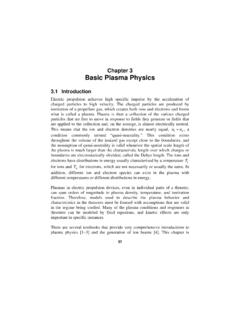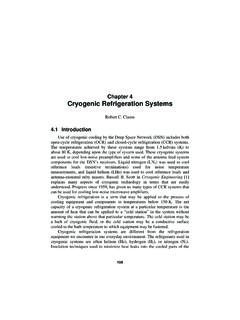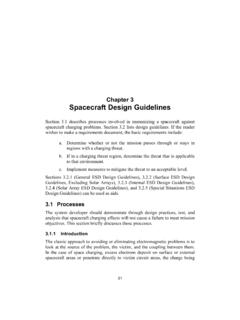Transcription of Fundamentals of Electric Propulsion: Ion and Hall Thrusters
1 Fundamentals of Electric propulsion : Ion and Hall Thrusters Dan M. Goebel and Ira Katz Jet propulsion Laboratory California Institute of Technology JPL SPACE SCIENCE AND TECHNOLOGY series Fundamentals of Electric propulsion : Ion and Hall Thrusters Dan M. Goebel and Ira Katz Jet propulsion Laboratory California Institute of Technology JPL SPACE SCIENCE AND TECHNOLOGY series Fundamentals of Electric propulsion : Ion and Hall Thrusters March 2008 The research described in this publication was carried out at the Jet propulsion Laboratory, California Institute of Technology, under a contract with the National Aeronautics and Space Administration.
2 Reference herein to any specific commercial product, process, or service by trade name, trademark, manufacturer, or otherwise, does not constitute or imply its endorsement by the United States Government or the Jet propulsion Laboratory, California Institute of Technology. v Table of Contents Note from the series xiii Preface .. xv Acknowledgments ..xvii Chapter 1: Electric propulsion Electric Thruster Ion Thruster Hall Thruster Beam/Plume Chapter 2: Thruster The Rocket Force Transfer in Ion and Hall Specific Thruster Power Neutral Densities and Ingestion in Electric Homework Chapter 3: Basic Plasma Maxwell s Single Particle vi Particle Energies and Plasma as a Momentum Particle Conservation.
3 48 Energy Conservation ..51 Diffusion in Partially Ionized Diffusion and Mobility Without a Magnetic Diffusion Across Magnetic Sheaths at the Boundaries of Debye Sheaths ..73 Pre-Sheaths ..76 Child Langmuir Generalized Sheath Double Summary of Sheath Effects ..86 Homework Chapter 4: Ion Thruster Plasma Idealized Ion Thruster Plasma DC Discharge Ion Generalized 0-D Ring-Cusp Ion Thruster Model ..102 Magnetic Multipole Electron Confinement ..108 Ion Confinement at the Anode Ion and Excited Neutral Production.
4 117 Neutral and Primary Densities in the Discharge Power and Energy Balance in the Discharge Chamber ..124 Discharge Discharge Recycling Limitations of a 0-D Kaufman Ion rf Ion Microwave Ion vii 2-D Computer Models of the Ion Thruster Discharge Neutral Atom Model ..172 Primary Electron Motion and Ionization Discharge Chamber Model Homework Chapter 5: Ion Thruster Accelerator Grid Ion Accelerator Ion Ion Trajectories ..200 Perveance Limits ..204 Grid Expansion and Electron High-Voltage Electrode Breakdown.
5 217 Molybdenum Carbon Carbon Composite Pyrolytic Hold-off and Conditioning in Ion Ion Accelerator Grid Grid Models ..227 Barrel Erosion ..230 Pits-and-Grooves Erosion ..232 Homework Chapter 6: Hollow Cathode Thermionic Electron Emitter Insert Region Orifice Region Hollow Cathode Thermal viii Cathode Plume-Region Hollow Cathode Dispenser Cathodes in Insert Cathode Insert Barium Depletion Bulk-Material Insert Life ..302 Cathode Keeper Wear and Hollow Cathode Homework Chapter 7: Hall Thruster Operating Principles and Crossed-Field Structure and the Hall Ionization Length and Potential and Current Hall Thruster Performance Hall Thruster Multiply Charged Ion Dominant Power Loss Mechanisms.
6 347 Plasma Electron Temperature ..357 Hall Thruster Efficiency (Dielectric Walls)..359 TAL Hall Thruster Efficiency (Metallic Walls) ..363 Dielectric-Wall Versus Metallic-Wall Comparison ..364 Channel Physics and Numerical Hybrid Hall Thruster Steady-State Modeling Oscillations in Hall Hall Thruster Homework Chapter 8: Ion and Hall Thruster ix Plume Plume Measurements ..395 Flight Laboratory Plume Measurements ..398 Plume Primary Beam Neutral Gas Plumes.
7 407 Secondary-Ion Generation ..408 Spacecraft Momentum of the Plume Particles ..412 Sputtering and Plasma Interactions with Solar Interactions with Microwave Phase Shift ..418 Plume Plasma Optical Homework Chapter 9: Flight Ion and Hall Ion Hall Appendices A: B: Gas Flow Unit Conversions and Cathode Pressure C: Energy Loss by D: Ionization and Excitation Cross Sections for E: Ionization and Excitation Reaction Rates for Xenon in Maxwellian F: Electron Relaxation and Thermalization G.
8 Clausing Factor Monte Carlo xi Note from the series Editor The Jet propulsion Laboratory (JPL) Space Science and Technology series broadens the range of the ongoing JPL Deep Space Communications and Navigation series to include disciplines other than communications and navigation in which JPL has made important contributions. The books are authored by scientists and engineers with many years of experience in their respective fields, and lay a foundation for innovation by communicating state-of-the-art knowledge in key technologies.
9 The series also captures fundamental principles and practices developed during decades of space exploration at JPL, and celebrates the successes achieved. These books will serve to guide a new generation of scientists and engineers. We would like to thank the Office of the Chief Scientist and Chief Technologist for their encouragement and support. In particular, we would like to acknowledge the support of Thomas A. Prince, former JPL Chief Scientist; Erik K. Antonsson, former JPL Chief Technologist; Daniel J.
10 McCleese, JPL Chief Scientist; and Paul E. Dimotakis, JPL Chief Technologist. Joseph H. Yuen, Editor-in-Chief JPL Space Science and Technology series Jet propulsion Laboratory California Institute of Technology xiii Foreword I am very pleased to commend the Jet propulsion Laboratory (JPL) Space Science and Technology series , and to congratulate and thank the authors for contributing their time to these publications. It is always difficult for busy scientists and engineers, who face the constant pressures of launch dates and deadlines, to find the time to tell others clearly and in detail how they solved important and difficult problems, so I applaud the authors of this series for the time and care they devoted to documenting their contributions to the adventure of space exploration.



